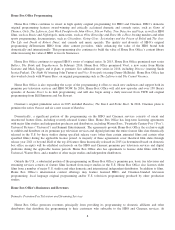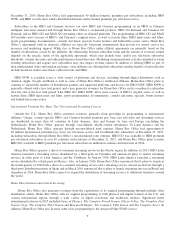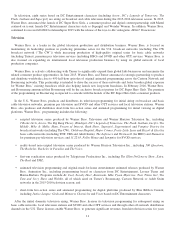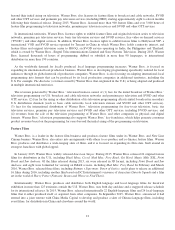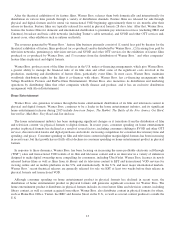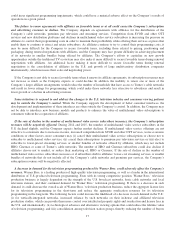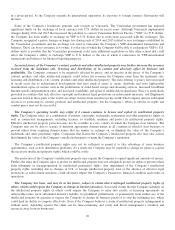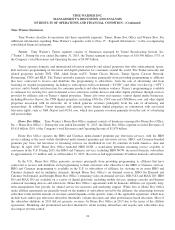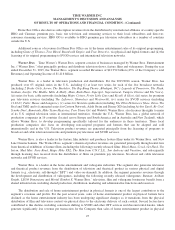Time Magazine 2015 Annual Report Download - page 30
Download and view the complete annual report
Please find page 30 of the 2015 Time Magazine annual report below. You can navigate through the pages in the report by either clicking on the pages listed below, or by using the keyword search tool below to find specific information within the annual report.RISK FACTORS
The Company must respond successfully to ongoing changes in the U.S. television industry and consumer viewing
patterns to remain competitive. The Company derives a substantial portion of its revenues and profits from its cable
networks and premium pay television services and the production and licensing of television programming to broadcast and
cable networks and premium pay television services. The U.S. television industry is evolving, with developments in
technology leading to new video services that are experiencing rapid growth, resulting in higher overall video content
consumption as well as a shift in consumer viewing patterns as consumers seek more control over when, where and how they
view video content. These changes pose risks to the traditional U.S. television industry and some of the Company’s longest-
standing business models, including (i) the disruption of the traditional television content delivery model by video streaming
services, some of which are growing rapidly, which could lead to further declines in subscribers to multichannel video
services and to lower growth in subscription revenues; (ii) the disruption of the advertising supported television model due to
increased video consumption on digital distribution platforms with no advertising or less advertising than on television
networks, time shifted viewing of television programming, and the use of digital video recorders to skip advertisements; and
(iii) the risk that one or more of the Company’s networks will not be included in “skinny bundles” of networks being offered
by some affiliates. As a result of some of these risks, in 2015, the U.S. television industry experienced declines in subscribers
to multichannel video services and industry-wide declines in ratings for programming, which has negatively affected
advertising and subscription revenues. Actions by the multichannel video services to counteract the subscriber declines, such
as offering smaller bundles of networks, may not be sufficient and may present other risks to the Company’s businesses. The
Company’s strategy to address these risks, including continuing to invest in high-quality original programming to strengthen
its position within the traditional TV ecosystem, investing in technology and working with affiliates to enhance the value of
multichannel video subscriptions to consumers, and selectively licensing its content to SVOD services while pursuing new
opportunities for the distribution of its content, including on OTT services, may not be successful. The Company may incur
significant costs to implement its strategy and respond to and mitigate the risks from these changes, and, if not successful,
could experience a significant adverse impact on the Company’s competitive position, businesses and results of operations.
The popularity of content is difficult to predict and can change rapidly, and low public acceptance of the Company’s
content will adversely affect its results of operations. The revenues derived from the sale, distribution and licensing of
television programming, feature films, videogames and other content depend primarily on widespread public acceptance of
that content, which is difficult to predict and can change rapidly. The Company must invest substantial amounts in the
production and marketing of its content before it learns whether such content will reach anticipated levels of popularity with
consumers. The popularity of the Company’s content depends on many factors, only some of which are within the
Company’s control. Examples include the popularity of competing content (including locally produced content
internationally), the availability of alternative forms of leisure and entertainment activities, the Company’s ability to maintain
or develop strong brand awareness and target key audiences, and the Company’s ability to successfully anticipate (and timely
adapt its content to) changes in consumer tastes in the many countries and territories in which the Company operates. Low
public acceptance of the Company’s content will adversely affect its results of operations.
Generally, feature films that perform well at the global box office also have commercial success in subsequent distribution
channels. Therefore, the underperformance of a feature film, especially an “event” film, at the global box office can result in
lower than expected revenues for the Company from the license of the film to broadcast and cable networks and SVOD and
other OTT services, sales of the film in digital and physical formats, and from the sale of videogames or licenses for
consumer products based on such film. If a new “event” film fails to achieve commercial success at the global box office, it
would limit the Company’s ability to create a new theatrical franchise based on the film or characters featured in such film.
The failure to develop successful new theatrical franchises could have an adverse effect on the Company’s results of
operations.
Low ratings for television programming produced by the Company may lead to the cancellation of a program and can
negatively affect future license fees for the cancelled program. A decline in the ratings or popularity of the television
programming aired on Turner’s cable networks can negatively affect advertising revenues for Turner’s cable networks in the
near term and, over a longer period of time, could adversely affect subscription revenues and the distribution potential of a
Turner network. A decline in the popularity of HBO’s and Cinemax’s programming could, over a period of time, cause
subscribers to cancel their subscriptions, which in turn could adversely affect both the Company’s subscription and content
licensing revenues. If the Company decides to no longer air programming due to low ratings or other factors, the Company
16




